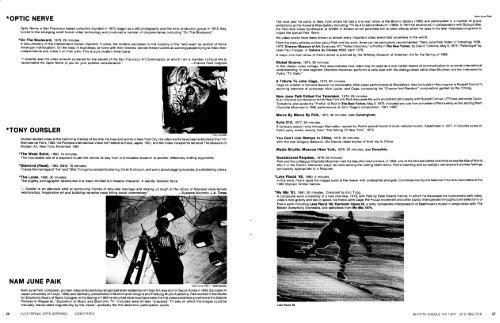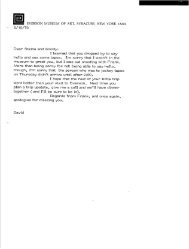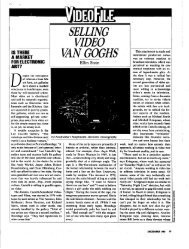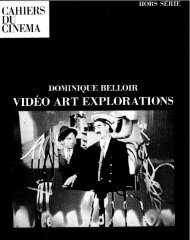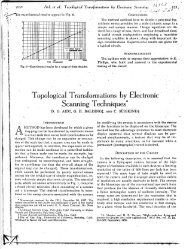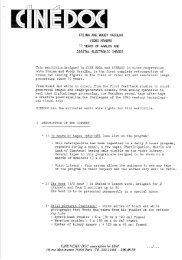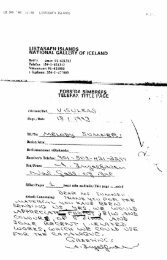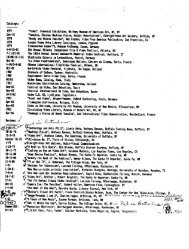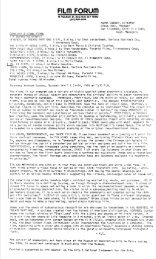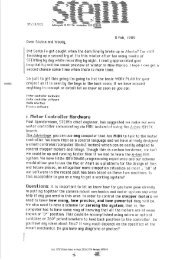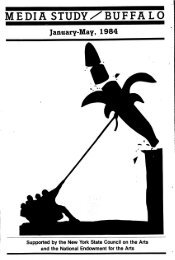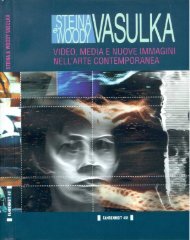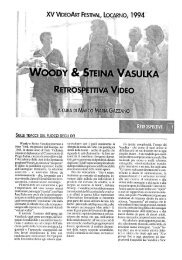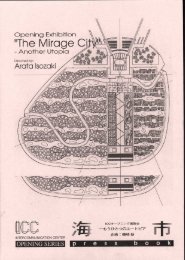ELECTRONIC ARTS INTERMIX VIDEOTAPES - Vasulka.org
ELECTRONIC ARTS INTERMIX VIDEOTAPES - Vasulka.org
ELECTRONIC ARTS INTERMIX VIDEOTAPES - Vasulka.org
Create successful ePaper yourself
Turn your PDF publications into a flip-book with our unique Google optimized e-Paper software.
*OPTIC NERVE<br />
Optic Nerve, a San Francisco based collective founded in 1970, began as a still photography and film strip production group . In 1972, they<br />
turned to the emerging small format video technology and produced a number of documentaries, including "On The Boulevard ."<br />
*On The Boulevard, 1979,29 minutes.<br />
A documentary of the Independent Owner-Operator Trucker, the modern successor to the Cowboy of the "wild west" as symbol of fierce<br />
American individualism . On the road, in truckstops, at home with their families, we see these truckers as working people trying to retain their<br />
independence and make it on their own . This is pure modern Americana .<br />
"I recently saw the video artwork screened for the benefit of the San Francisco Art Commission, of which I am a member. I should like to<br />
recommend the Optic Nerve to you for your positive consideration." -Francis Ford Coppola<br />
*TONY OURSLER<br />
Oursler studied video at the California Institute of the Arts. He lives and works in New York City . His video works have been exhibited atthe 11th<br />
Biennale de Paris, 1980, the Portopia International Video Art Festival at Kobe, Japan, 1981, and the Video Viewpoints series atThe Museum of<br />
Modern Art, New York, November 1981 .<br />
*The Weak Bullet, 1980,14 minutes.<br />
The improbable tale of a wayward bullet that wends its way from one troubled situation to another, effectively ending arguments.<br />
*Diamond (Head), 1980, B&W,10 minutes.<br />
Traces the marriage of"He" and "She" through a constant bickering, the birth of a son, and worry about sagging muscles, to a shattering climax .<br />
*The Loner, 1980, 30 minutes .<br />
The slightly pornographic adventures of a mean-minded but likeable character. A weirdly fantastic farce.<br />
". . .Oursler is an absolute whiz at puncturing cliches of fairy-tale marriage and making us laugh at the idiocy of televised male-female<br />
relationships. Imaginative art and bubbling narrative mask biting social commentary." -Suzanne Muchnic, L.A . Times<br />
NAM JUNE PAIK<br />
26 <strong>ELECTRONIC</strong> <strong>ARTS</strong> <strong>INTERMIX</strong> <strong>VIDEOTAPES</strong><br />
Tony Oursier<br />
Nam June Paik - Anti-Gravity<br />
Nam June Paik, composer, pioneer video artist and long recognized elder statesman of Video Art,was born in Seoul, Korea in 1932. Educated in<br />
Japan (University of Tokyo, 1956) and Germany (Universities of Munich and Cologne and Freiburg Music Academy), Paik worked in the Studio<br />
for Electronic Music of Radio Cologne. In the Spring of 1963 he mounted what must have been the first video exhibition anywhere atthe Galerie<br />
Parnass in Wuppertal, "Exposition of Music and Electronic TV ." Included were thirteen "prepared" TV sets on which the images could be<br />
manually manipulated magnetically by the viewer-probably the first electronic participation works .<br />
The next year he came to New York where he had a one-man show at the Bonino Gallery (1965) and participated in a number of group<br />
exhibitions at the Howard Wise Gallery including "TV As A Creative Medium" (1969) . In 1970 he developed, in collaboration with Schuya Abe,<br />
the Paik-Abe Video Synthesizer at WGBH in Boston which permitted him to attain effects which he uses in his later videotape programs to<br />
impart the typical Paik flavor .<br />
His video works have been shown at almost every important video event held anywhere in the world .<br />
From the many articles written about Paik and his work, three can be particularly recommended ; "Nam June Paik : Video'n' Videology 1959-<br />
1973" Everson Museum of Art, Syracuse, NY ; "Video Visionary," a Profile in The New Yorker, by Calvin Tomkins, May 5,1975 ; "Paikologie" by<br />
Jean-Paul Fargier, in Cahiers du Cinema #299, April 1979 .<br />
A major one-man show of Paik's works is planned by the Whitney Museum of American Art for the Spring of 1982 .<br />
Global Groove, 1973,30 minutes .<br />
In this classic video collage, Paik demonstrates how video may be used as a non-verbal means of communication to promote international<br />
understanding . In one segment Charlotte Moorman performs a cello duet with the distinguished cellist Alan Shulman, but her instrument is<br />
Paik's "TV Cello ."<br />
A Tribute To John Cage, 1973, 60 minutes .<br />
Cage re-creates in Harvard Square his memorable 1952 piano performance at Woodstock . Also included in the program is Russell Connor's<br />
stunning interview of composer Alvin Lucier, and Cage, composing his "Chance And Random" composition guided by the I'Ching .<br />
Nam June Paik Edited For Television, 1975 . 29 minutes .<br />
In an informal conversation at his New York loft, Paik discusses his work and artistic philosophy with Russell Connor, VTR host, and writer Calvin<br />
Tompkins, who wrote the "Profile" of Paik in The New Yorker, May 5,1975 . Included are cuts froma number of Paik's early works,among them<br />
Charlotte Moorman's 1965 performance of John Cage's composition "26'1 .1499 :"<br />
Merce By Merce By Paik, 1975, 30 minutes . (see Cunningham)<br />
Suite 212, 1977, 30 minutes .<br />
A furiously paced romp through Manhattan, spiced by Paik's special brand of multi-national humor . Assembled in 1977, it includes some of<br />
Paik's early works, among them "The Selling Of New York;" 1972 .<br />
You Can't Lick Stamps In China, 1978,30 minutes .<br />
With the late Gregory Battcock . Old friends relate stories of their trip to China .<br />
Media Shuttle : Moscow/New York, 1978,30 minutes . (see Devyatkin)<br />
Guadalcanal Requiem, 1979,29 minutes .<br />
Paik and his colleague Charlotte Moorman visitthe beautiful island where, in 1944, one of the fiercest battles of all time turned the tide ofWorld<br />
War II in the Pacific . Moorman plays her cello among the rusting battle relics . Paik's haunting and surrealistic camerawork evokes feelings<br />
particularly appropriate to a Requiem .<br />
*Lake Placid '80, 1980, 4 minutes .<br />
In this work, Paik's rapid fire images burst at the viewer with unabashed energies . Commissioned by the National Fine Arts Committee of the<br />
1980 Olympic Winter Games.<br />
*My Mix '81, 1981, 30 minutes. Compiled by Eric Trigg.<br />
A composite work consisting of a rare interview, 1978, with Paik by Ester Swartz Harriot, in which he discusses his involvement with video,<br />
video's non-gravity and sex in space, his friend John Cage, the Fluxus movement and other topics . Interspersed throughout are selections of<br />
Paik's work including Lake Placid '80, Electronic Opera #2, a witty, surrealistic interpretation of Beethoven's music in conjunction with The<br />
Boston Symphony Orchestra, and selections from My Mix 1974 .<br />
Lake Placid '80<br />
84 FIFTH AVENUE, NY 10011 (212)989-2316<br />
Nam June Paik


